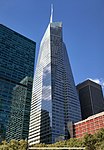National Debt Clock

The National Debt Clock is a billboard-sized running total display that shows the United States gross national debt and each American family's share of the debt. It is currently installed on the western side of One Bryant Park, west of Sixth Avenue between 42nd and 43rd Streets in Manhattan, New York City. It was the first debt clock installed anywhere. The clock's first incarnation was installed in 1989 on Sixth Avenue between 42nd and 43rd Streets, one block away from Times Square, by New York real estate developer Seymour Durst, who wanted to highlight the rising national debt. In 2004, the clock was dismantled and a new one installed near 44th Street and Sixth Avenue. In 2008, the U.S. national debt exceeded $10 trillion, one more digit than the clock could display. The lit dollar-sign in the clock's leftmost digit position was later changed to the "1" digit to represent the ten-trillionth place. In 2017, the clock was moved to One Bryant Park, near the original location.
Excerpt from the Wikipedia article National Debt Clock (License: CC BY-SA 3.0, Authors, Images).National Debt Clock
West 42nd Street, New York Manhattan
Geographical coordinates (GPS) Address Nearby Places Show on map
Geographical coordinates (GPS)
| Latitude | Longitude |
|---|---|
| N 40.7555 ° | E -73.9848 ° |
Address
Bank of America Tower
West 42nd Street 115
10036 New York, Manhattan
New York, United States
Open on Google Maps








